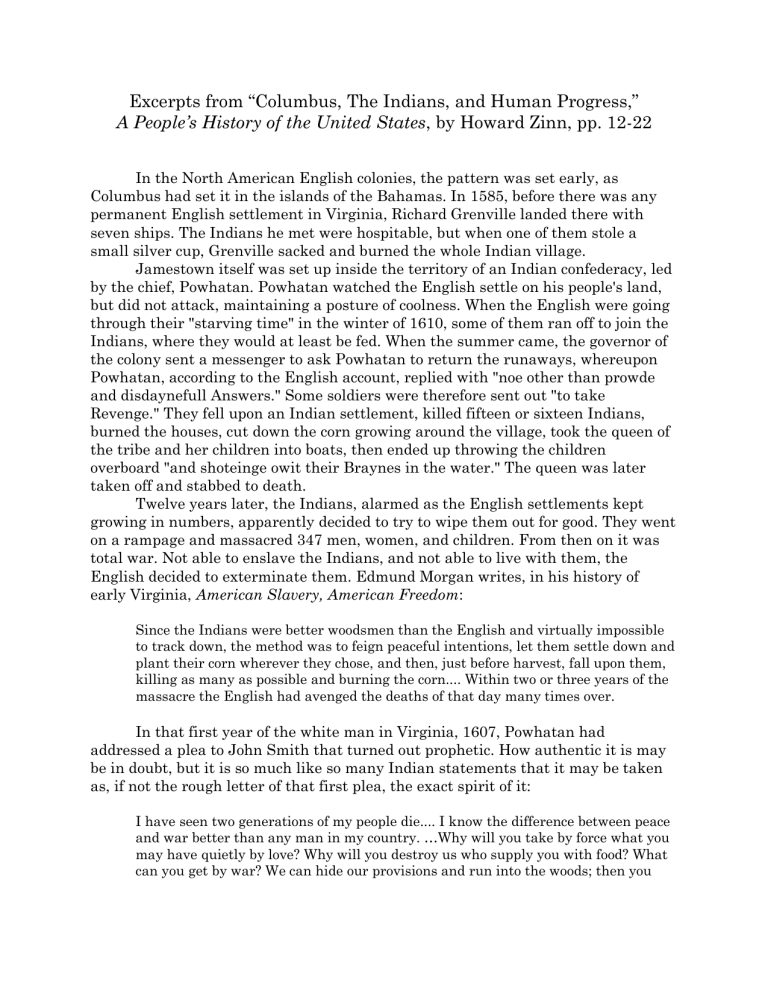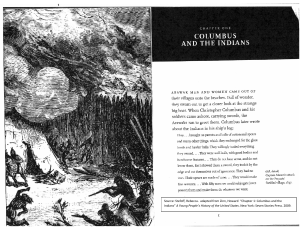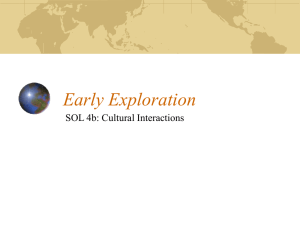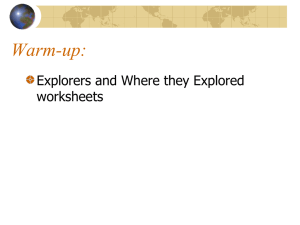Howard Zenn - Columbus-the-indians-and-human-progress-a-people-s-history-of-the-united-states-by-howard-zinn-pp
advertisement

Excerpts from “Columbus, The Indians, and Human Progress,” A People’s History of the United States, by Howard Zinn, pp. 12-22 In the North American English colonies, the pattern was set early, as Columbus had set it in the islands of the Bahamas. In 1585, before there was any permanent English settlement in Virginia, Richard Grenville landed there with seven ships. The Indians he met were hospitable, but when one of them stole a small silver cup, Grenville sacked and burned the whole Indian village. Jamestown itself was set up inside the territory of an Indian confederacy, led by the chief, Powhatan. Powhatan watched the English settle on his people's land, but did not attack, maintaining a posture of coolness. When the English were going through their "starving time" in the winter of 1610, some of them ran off to join the Indians, where they would at least be fed. When the summer came, the governor of the colony sent a messenger to ask Powhatan to return the runaways, whereupon Powhatan, according to the English account, replied with "noe other than prowde and disdaynefull Answers." Some soldiers were therefore sent out "to take Revenge." They fell upon an Indian settlement, killed fifteen or sixteen Indians, burned the houses, cut down the corn growing around the village, took the queen of the tribe and her children into boats, then ended up throwing the children overboard "and shoteinge owit their Braynes in the water." The queen was later taken off and stabbed to death. Twelve years later, the Indians, alarmed as the English settlements kept growing in numbers, apparently decided to try to wipe them out for good. They went on a rampage and massacred 347 men, women, and children. From then on it was total war. Not able to enslave the Indians, and not able to live with them, the English decided to exterminate them. Edmund Morgan writes, in his history of early Virginia, American Slavery, American Freedom: Since the Indians were better woodsmen than the English and virtually impossible to track down, the method was to feign peaceful intentions, let them settle down and plant their corn wherever they chose, and then, just before harvest, fall upon them, killing as many as possible and burning the corn.... Within two or three years of the massacre the English had avenged the deaths of that day many times over. In that first year of the white man in Virginia, 1607, Powhatan had addressed a plea to John Smith that turned out prophetic. How authentic it is may be in doubt, but it is so much like so many Indian statements that it may be taken as, if not the rough letter of that first plea, the exact spirit of it: I have seen two generations of my people die.... I know the difference between peace and war better than any man in my country. …Why will you take by force what you may have quietly by love? Why will you destroy us who supply you with food? What can you get by war? We can hide our provisions and run into the woods; then you will starve for wronging your friends. Why are you jealous of us? We are unarmed, and willing to give you what you ask, if you come in a friendly manner, …. When the Pilgrims came to New England they too were coming not to vacant land but to territory inhabited by tribes of Indians. The governor of the Massachusetts Bay Colony, John Winthrop, created the excuse to take Indian land by declaring the area legally a "vacuum." The Indians, he said, had not "subdued" the land, and therefore had only a "natural" right to it, but not a "civil right." A "natural right" did not have legal standing. The Puritans also appealed to the Bible, Psalms 2:8: "Ask of me, and I shall give thee, the heathen for thine inheritance, and the uttermost parts of the earth for thy possession." And to justify their use of force to take the land, they cited Romans 13:2: "Whosoever therefore resisteth the power, resisteth the ordinance of God: and they that resist shall receive to themselves damnation." The Puritans lived in uneasy truce with the Pequot Indians, who occupied what is now southern Connecticut and Rhode Island. But they wanted them out of the way; they wanted their land. And they seemed to want also to establish their rule firmly over Connecticut settlers in that area. The murder of a white trader, Indian-kidnaper, and troublemaker became an excuse to make war on the Pequots in 1636. … So, the war with the Pequots began. Massacres took place on both sides. The English developed a tactic of warfare used earlier by Cortes and later, in the twentieth century, even more systematically: deliberate attacks on noncombatants for the purpose of terrorizing the enemy. … So the English set fire to the wigwams of the village. By their own account: "The Captain also said, We must Burn Them; and immediately stepping into the Wigwam ... brought out a Fire Brand, and putting it into the Matts with which they were covered, set the Wigwams on Fire." William Bradford, in his History of the Plymouth Plantation written at the time, describes John Mason's raid on the Pequot village: Those that scaped the fire were slaine with the sword; some hewed to peeces, others rune throw with their rapiers, so as they were quickly dispatchte, and very few escaped. It was conceived they thus destroyed about 400 at this time. It was a fearful sight to see them thus frying in the fyer, and the streams of blood quenching the same, and horrible was the stincke and sente there of, but the victory seemed a sweete sacrifice, and they gave the prayers thereof to God, who had wrought so wonderfully for them, thus to inclose their enemise in their hands, and give them so speedy a victory over so proud and insulting an enimie. As Dr. Cotton Mather, Puritan theologian, put it: "It was supposed that no less than 600 Pequot souls were brought down to hell that day." The war continued. Indian tribes were used against one another, and never seemed able to join together in fighting the English. [Francis] Jennings sums up: 2 The terror was very real among the Indians, but in time they came to meditate upon its foundations. They drew three lessons from the Pequot War: (1) that the Englishmen's most solemn pledge would be broken whenever obligation conflicted with advantage; (2) that the English way of war had no limit of scruple or mercy; and (3) that weapons of Indian making were almost useless against weapons of European manufacture. These lessons the Indians took to heart. … For a while, the English tried softer tactics. But ultimately, it was back to annihilation. The Indian population of 10 million that lived north of Mexico when Columbus came would ultimately be reduced to less than a million. Huge numbers of Indians would die from diseases introduced by the whites. A Dutch traveler in New Netherland wrote in 1656 that "the Indians ... affirm, that before the arrival of the Christians, and before the smallpox broke out amongst them, they were ten times as numerous as they now are, and that their population had been melted down by this disease, whereof nine-tenths of them have died." When the English first settled Martha's Vineyard in 1642, the Wampanoags there numbered perhaps three thousand. There were no wars on that island, but by 1764, only 313 Indians were left there. Similarly, Block Island Indians numbered perhaps 1,200 to 1,500 in 1662, and by 1774 were reduced to fifty-one. …Was all this bloodshed and deceit—from Columbus to Cortes, Pizarro, the Puritans—a necessity for the human race to progress from savagery to civilization? [Is it right to bury] the story of genocide inside a more important story of human progress? Perhaps a persuasive argument can be made—as it was made by Stalin when he killed peasants for industrial progress in the Soviet Union, as it was made by Churchill explaining the bombings of Dresden and Hamburg, and Truman explaining Hiroshima. But how can the judgment be made if the benefits and losses cannot be balanced because the losses are either unmentioned or mentioned quickly? That quick disposal might be acceptable ("Unfortunate, yes, but it had to be done") to the middle and upper classes of the conquering and "advanced" countries. But is it acceptable to the poor of Asia, Africa, Latin America, or to the prisoners in Soviet labor camps, or the blacks in urban ghettos, or the Indians on reservations— to the victims of that progress which benefits a privileged minority in the world? … If there are necessary sacrifices to be made for human progress, is it not essential to hold to the principle that those to be sacrificed must make the decision themselves? We can all decide to give up something of ours, but do we have the right to throw into the pyre the children of others, or even our own children, for a progress which is not nearly as clear or present as sickness or health, life or death? … Beyond all that, how certain are we that what was destroyed was inferior? Who were these people who came out on the beach and swam to bring presents to Columbus and his crew, who watched Cortes and Pizarro ride through their countryside, who peered out of the forests at the first white settlers of Virginia and Massachusetts? Columbus called them Indians, because he miscalculated the size of the earth. In this book we too call them Indians, with some reluctance, because it 3 happens too often that people are saddled with names given them by their conquerors. And yet, there is some reason to call them Indians, because they did come, perhaps 25,000 years ago, from Asia, across the land bridge of the Bering Straits (later to disappear under water) to Alaska. Then they moved southward, seeking warmth and land, in a trek lasting thousands of years that took them into North America, then Central and South America. In Nicaragua, Brazil, and Ecuador their petrified footprints can still be seen, along with the print of bison, who disappeared about five thousand years ago, so they must have reached South America at least that far back. Widely dispersed over the great land mass of the Americas, they numbered approximately 75 million people by the time Columbus came, perhaps 25 million in North America. Responding to the different environments of soil and climate, they developed hundreds of different tribal cultures, perhaps two thousand different languages. They perfected the art of agriculture, and figured out how to grow maize (corn), which cannot grow by itself and must be planted, cultivated, fertilized, harvested, husked, shelled. They ingeniously developed a variety of other vegetables and fruits, as well as peanuts and chocolate and tobacco and rubber. On their own, the Indians were engaged in the great agricultural revolution that other peoples in Asia, Europe, Africa were going through about the same time. …By the time of Christ and Julius Caesar, there had developed in the Ohio River Valley a culture of so-called Moundbuilders, Indians who constructed thousands of enormous sculptures out of earth, sometimes in the shapes of huge humans, birds, or serpents, sometimes as burial sites, sometimes as fortifications. One of them was miles long, enclosing 100 acres. These Moundbuilders seem to have been part of a complex trading system of ornaments and weapons from as far off as the Great Lakes, the Far West, and the Gulf of Mexico. About A.D. 500, as this Moundbuilder culture of the Ohio Valley was beginning to decline, another culture was developing westward, in the valley of the Mississippi, centered on what is now St. Louis. It had an advanced agriculture, included thousands of villages, and also built huge earthen mounds as burial and ceremonial places near a vast Indian metropolis that may have had thirty thousand people. The largest mound was 100 feet high, with a rectangular base larger than that of the Great Pyramid of Egypt. In the city, known as Cahokia, were toolmakers, hide dressers, potters, jewelry makers, weavers, salt makers, copper engravers, and magnificent ceramists. One funeral blanket was made of twelve thousand shell beads. … In the villages of the Iroquois, land was owned in common and worked in common. Hunting was done together, and the catch was divided among the members of the village. Houses were considered common property and were shared by several families. The concept of private ownership of land and homes was foreign to the Iroquois. A French Jesuit priest who encountered them in the 1650s wrote: "No poorhouses are needed among them, because they are neither mendicants nor 4 paupers.... Their kindness, humanity and courtesy not only makes them liberal with what they have, but causes them to possess hardly anything except in common." Women were important and respected in Iroquois society. Families were matrilineal. That is, the family line went down through the female members, whose husbands joined the family, while sons who married then joined their wives' families. Each extended family lived in a "long house." When a woman wanted a divorce, she set her husband's things outside the door. … Children in Iroquois society, while taught the cultural heritage of their people and solidarity with the tribe, were also taught to be independent, not to submit to overbearing authority. They were taught equality in status and the sharing of possessions. The Iroquois did not use harsh punishment on children; they did not insist on early weaning or early toilet training, hut gradually allowed the child to learn self-care. All of this was in sharp contrast to European values as brought over by the first colonists, a society of rich and poor, controlled by priests, by governors, by male heads of families…. … So, Columbus and his successors were not coming into an empty wilderness, but into a world which in some places was as densely populated as Europe itself, where the culture was complex, where human relations were more egalitarian than in Europe, and where the relations among men, women, children, and nature were more beautifully worked out than perhaps any place in the world. They were people without a written language, but with their own laws, their poetry, their history kept in memory and passed on, in an oral vocabulary more complex than Europe's, accompanied by song, dance, and ceremonial drama. They paid careful attention to the development of personality, intensity of will, independence and flexibility, passion and potency, to their partnership with one another and with nature. John Collier, an American scholar who lived among Indians in the 1920s and 1930s in the American Southwest, said of their spirit: "Could we make it our own, there would be an eternally inexhaustible earth and a forever lasting peace." Perhaps there is some romantic mythology in that. But the evidence from European travelers in the sixteenth, seventeenth, and eighteenth centuries, put together recently by an American specialist on Indian life, William Brandon, is overwhelmingly supportive of much of that "myth." Even allowing for the imperfection of myths, it is enough to make us question, for that time and ours, the excuse of progress in the annihilation of races, and the telling of history from the standpoint of the conquerors and leaders of Western civilization. 5



